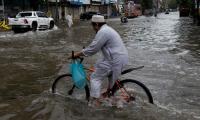HYDERABAD: Though, the recent rogue floods are being seen as a natural phenomenon, community elders as well as economists are looking at them as manmade, causing devastation to both urban as well as rural economy.
Dr Ghulam Ali Jariko, a well-known economist and former director Sindh Development Study Center (SDSC), Sindh University Jamshoro, said presently assessed crop losses might further increase as the rains were far from over in lower Sindh, panicking the already badly-hit growers further.
“It is too late to calculate the entire loss but, almost all crops including cotton and rice have either been destroyed completely or damaged partially because of the floods,” Jariko said.
He said after the floods, livestock, another major subsector of agriculture, would continue to face its impact for some time. “It is because, there are chances of an exponential increase in the mosquito population, another disaster, which may affect all animals, including buffaloes, cows, goats, and poultry,” Jariko feared.
He said the urban economy had already been under stress due to the coronavirus pandemic, the recent monster rains might add to the miseries of overall business activities as well as people at large.
“At this moment, the government needs to realise the flow of a number of natural waterways in all the areas have been either altered or blocked because of human intervention,” he said. Jariko urged the government to design policies for sustainable development, especially monitoring the unplanned urbanisation to avoid natural disasters like this these, as the province of Sindh was prone to natural disasters.
Presently, he pointed out that there was a huge foreign-funded project going on to improve urban planning, including drainage system in Karachi city. “Despite huge funding the metropolis has sunk and all political parties are looking silent, hurling allegations at each other.” This he said was likely to have long-term impacts, which might further stress the urban economy.
He was of the view that it happened due to politics and the political blame game, the price of which was being paid by poor citizens in rural and urban areas. “It is not only major cities like Karachi and others, where the politically-backed builders have encroached natural waterways and rain rivers for developing housing societies, it’s happening in the entire province where such schemes are replacing fertile agriculture lands, where otherwise food crops would be growing,” he said.
He said you could see all low-lying areas in villages, towns and major cities inundated, where newly-built housing schemes were underway ignoring the impacts of climate change.
“Heavy rains have washed away many roads, bridges, houses, and infrastructures like schools and health facilities in those areas,” Jariko said.
Taluka Khipro in Sanghar is among the badly hit areas, where 100 percent crops have been damaged, dealing farmers colossal losses.
Pervaiz Bahooto, a community activist of Johi, Dadu district, said besides Nai Gaj, there were three other major storm rivers, including Nai Andai, Nai Narri, and Nai Sukk, that had contributed to the devastation to the entire Kachho arid zone on August 26-27, 2020, which had already been laid to waste on August 8 (2020) by the Nai Gaj flood.
“In result, Wahi Pandhi and parts of Johi and other towns situated in depressed areas in Kachho have come under the flash flood water. Nai Andai runoff hit the area in the dark of the night, washing away almost everything in its way,” Bahooto said.
There were reports of missing women and livestock, which might have been taken away by the rogue waters, said Bahooto, who has been involved in rescue and food distribution activities with the government institutions and local non-governmental organisations (NGOs).
“At least 60 goats reportedly died. Two minor children were rescued by the local people from the flood water,” he said. Bahooto said the August 8 Nai Gaj flood had shaken the area and exposed incapability of the government authorities, which failed to rehabilitate the damages done previously and the flood in Nai Andai multiplied the devastation, disconnecting several villages from the rest of the world.
Kachho (arid zone) always depends on monsoon rains and natural rivers (starting from August to December) for cultivation and storing water for drinking purposes. These months are considered prosperous for the Kachho communities. But after consecutive floods in 2010 and 2011, this time around (2020) the people are experiencing miseries, having no idea how to face the challenges to survive.
He gave examples of towns in Kachho, which have been hit by the rainy rivers frequently. In some places, he said the similar floods in 2010, 2011 and later had already damaged embankments, which have not been rehabilitated till 2020.
The rescue operation is going on but there is no arrangement for providing food to the victims including those who have been moved to safer places and the ones still waiting for help in the isolated areas.
Altaf Mahesar of Basic Development Foundation (BDF), sharing his experiences of disaster mitigation plans, said the situation could be measured from the fact that earlier census had showed more than 70 percent population was living in rural areas and the rest in urban areas, but according to the latest up to 52 percent was now living in the urban areas, compared to 48 percent in rural.
“This gap shows how urbanisation is becoming more and more attractive for the people, migrating from villages to towns and cities in search of better living,” Mahsesar said.
He quoted reports, showing the common phenomenon being witnessed in all areas where several villages and small towns had been disconnected from the rest of the world and people were in immediate need of food to stay alive.
He said it more and more small landholders were selling their pieces of lands to real estate tycoons to develop residential colonies, being built without any planning to avoid natural disasters. “Small towns are growing into cities and large villages into towns, inviting people to develop their businesses there without knowing the natural calamities are around the corner due to climate change,” he said.
He criticised the Pakistan People’s Party-led government, which seemed to have failed to fulfill its promise to ensure provision of roti, kapra, aur makan (food, clothing, and shelter), the popular slogan, they used to get votes. “The people have been left at the mercy of back-to-back natural disasters making lives and livelihoods of the communities impossible,” Mahesar said.
This image uploaded on January 4, 2017, shows a Bank Alfalah branch. — Facebook/Sundar Interiors &...
An employee makes respiratory masks in a family-owned medical equipment factory in Miami, USA. — AFP/FileWASHINGTON:...
In this photo, workers operate a machine at a textile factory. — AFP/FileKARACHI: The All Pakistan Textile Mills...
Chairman TDAP Zubair Motiwala addresses a press conference on August 1, 2024. — Facebook/Trade Development...
A woman checks rice prices at a main wholesale market. — AFP/FileLAHORE: As political turmoil in the country...
A pedestrian walks past the Bank of England in London. — AFP/FileLONDON: The Bank of England cut interest rates from...







